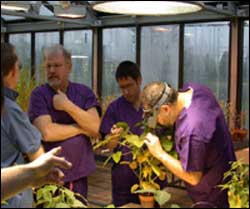Experts available to speak on the possible discovery of Asian Soybean Rust spores

Virginia Tech scientists say that there has been a change in the status of the fungus causing Asian Soybean Rust but that the new information is still too preliminary for any action on the part of the Commonwealth’s soybean producers.
A single cluster of six urediniospores found at Virginia Tech’s Tidewater Agricultural Research and Extension Center in Suffolk was identified by morphological characteristics as matching the description of the fungus.
“The spores in question appear to resemble the causal agent of Asian Soybean Rust, Phakopsora pachyrhizi, said Erik Stromberg, interim head of the Department of Plant Pathology, Physiology and Weed Science in Virginia Tech’s College of Agriculture and Life Sciences. “But we can not be absolutely certain that they are. The weather conditions between Aug. 5 and 11, the time the sample was found, were extremely hot and dry and not conducive for promoting the infection process. Researchers found no indication of Asian Soybean Rust when they examined the adjacent sentinel plots and other nearby fields. At this time, no recommendation for fungicide is warranted in Virginia. It is highly unlikely that Asian Soybean Rust will be detected in any soybeans in Virginia for at least three weeks.”
The presence of spores does not mean the infection is present. It means that the scouting for the disease will be intensified until the crop progresses through the most vulnerable stages from beginning pod fill up to full seed.
Farmers suspecting the presence of soybean rust in a field should contact the local Virginia Cooperative Extension office for help in confirming its identity. Virginia Tech has an intensive ongoing program for detection of the disease and warning growers of the need to apply fungicide sprays for disease control. Reports on the status of disease and field scouting are posted twice weekly on the website and there are recorded updates at 1-804-657-6450 ext. 103.
Soybean’s farm gate value in Virginia has ranged from $75 million to $100 million annually. The early warning provided by the scouting system will permit growers to act only when necessary. The primary tool for growers is the use of fungicides, which are costly and will not be effective if applied too early or too late. Research continues on finding resistant varieties.
Media Contact
All latest news from the category: Agricultural and Forestry Science
Newest articles

Silicon Carbide Innovation Alliance to drive industrial-scale semiconductor work
Known for its ability to withstand extreme environments and high voltages, silicon carbide (SiC) is a semiconducting material made up of silicon and carbon atoms arranged into crystals that is…

New SPECT/CT technique shows impressive biomarker identification
…offers increased access for prostate cancer patients. A novel SPECT/CT acquisition method can accurately detect radiopharmaceutical biodistribution in a convenient manner for prostate cancer patients, opening the door for more…

How 3D printers can give robots a soft touch
Soft skin coverings and touch sensors have emerged as a promising feature for robots that are both safer and more intuitive for human interaction, but they are expensive and difficult…





















